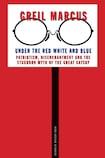
Any work about The Great Gatsby partakes of that source material’s magic, basking in its refulgence. Greil Marcus’s Under the Red White and Blue layers on the lustre, promising the encounter of a first-rate critical intellect – author of the brilliant Mystery Train, an attempt in part to fathom the US from the work of select recording artists – with a towering and uncanny American novel, one still read, not out of patriotic duty or grim pedagogical resolution, or as a challenge like forswearing alcohol for a month, but for deep, abiding pleasure.
“One . . . reason . . . Gatsby has remained alive is that it absorbed the ferment of its time,” writes Marcus. The ultimate period piece then; yet, timeless. Consider the mythic overtones Fitzgerald loaded into his text: Jacob’s Ladder materialising for a lovelorn adolescent Gatsby pining for Daisy in Louisville: “Out of the corner of his eye Gatsby saw that the blocks of the sidewalk really formed a ladder and mounted to a secret place above the trees – he could climb to it.”
Then there’s its ever-fresh feel, the result of scrupulous refrain from cliche, and slang. “The obvious phrase is simply not in it,” remarked HL Mencken (while snickering at the risible plot).
Marcus pegs the “allure” of the self-created Gatsby to Nick, unable to “imagine himself outside of his life as defined by other people”. He also picks out unnerving detail: the jarring use, to the contemporary eye, of “holocaust” to describe the killing spree that leaves Gatsby dead (to which he might have added the revelation, noted by Christopher Hitchens, that Meyer Wolfsheim toils behind the shingle of “The Swastika Holding Company”).
But Under the Red White and Blue (an alternative title contemplated by Fitzgerald that captures Gatsby’s vaulting ambition) is principally a disquisition on Gatsby’s post-publication afterlife as a free-standing cultural artefact with seemingly bottomless reverberance: “[C]ontinually taken up by other artists, its characters evolving into archetypes, or the characters brought down to earth and imbued with new personality in new work and then devolving back into archetypes that long precede the names Fitzgerald gave them.”
Overwrought methodology
Yet so many derivative productions closed their mind to these resonances. The travesties are legion. The execrable 1949 movie took especially diabolical license, recasting brutish Tom as a good egg; meanwhile a guilt-wracked Gatsby intent on confessing his misdeeds is excruciatingly ventriloquised: “I owe that to a kid named Jimmy Gatz – me, Nick, me . . .”
Unfortunately, Under the Red White and Blue is marred by self-indulgence. Marcus follows his pet interests. The result is a torrent of self-absorbed, insufficiently contextualised discursions (on Moby Dick, bluesmen, hard-boiled crime fiction, police procedurals) and free-association riffs retailed in hectic sub-Pauline Kael prose. Its accounts of movie and stage adaptations are mostly description, yielding scant critical insight. The overall effect is of a logorrhoea of pop culture arcana: the critic as garrulous Danny Baker blabbermouth.
A lengthy interlude on Moby Dick supplies an example of this overwrought method, glancing off sundry pop-culture references before proclaiming, “You’re rereading [Moby Dick] if you recall Elvis Presley in 1968 facing the white faces of his audience for the first time in seven years and against the blankness of that unknown hoisting a microphone stand like a harpoon, thrusting it over the crowd, and shouting ‘Moby Dick!’”
How so? What’s the wider import of a stage-frightened Elvis sweating bullets into a leather jumpsuit he’d have to be cut out of at the end of the show horsing around with a mic? Was the King a Melvillian (Peter Guralnick’s biographies suggest his literary tastes ran more toward the new age/spiritual) making a sly allegorical point about facing down the white whale of performance anxiety?
Wonder
This indiscriminate feel extends to language. It’s hard to get hold of the business end of a sentence that, including embedded quote, runs to 220 words. This is not David Foster Wallace stress-testing language and grammar to wrest meaning from them, his struggle writ on the page-Marcus isn’t working at that level here. It’s taxing on the reader; at 154 pages, Under the Red White and Blue is Gatsby-length but feels longer.
Perhaps there’s a category error in the application to literary criticism of a style from music writing, and a dated one at that. Marcus is of a cohort of lionised rock critics from the 1970s when not just rock-stars but those who covered them were gods. Their work - James Wolcott from CBGB, Lester Bangs on Iggy Pop - was expansive and exuberant but also long on inside references and grandiosity.
But if Under the Red White and Blue underwhelms, it delivers on one front: quoting generously from Gatsby itself. Granted it’s a target-rich environment, but there’s an art to this and the excerpts are well-chosen. Anything that drives readers back to a transcendent work, fully “commensurate to [our] capacity for wonder”, is to be commended.











